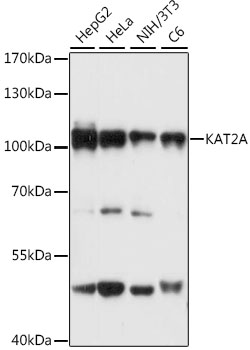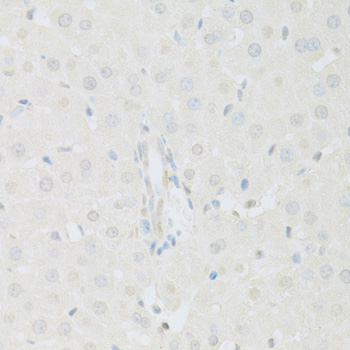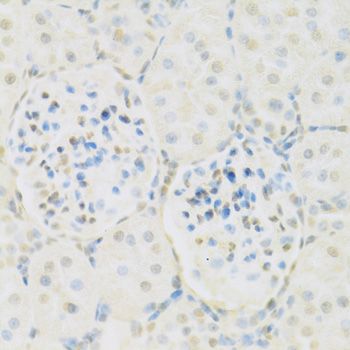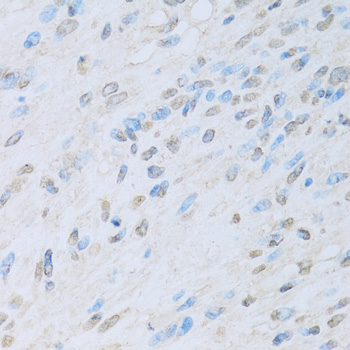-
Product Name
KAT2A Polyclonal Antibody
- Documents
-
Description
Polyclonal antibody to KAT2A
-
Tested applications
WB, IHC, IF
-
Species reactivity
Human, Mouse, Rat
-
Alternative names
KAT2A antibody; GCN5 antibody; GCN5L2 antibody; PCAF-b antibody; hGCN5 antibody; lysine acetyltransferase 2A antibody
-
Isotype
Rabbit IgG
-
Preparation
Antigen: Recombinant fusion protein containing a sequence corresponding to amino acids 1-100 of human KAT2A (NP_066564.2).
-
Clonality
Polyclonal
-
Formulation
PBS with 0.02% sodium azide, 50% glycerol, pH7.3.
-
Storage instructions
Store at -20℃. Avoid freeze / thaw cycles.
-
Applications
WB 1:200 - 1:2000
IHC 1:50 - 1:200
IF 1:50 - 1:200 -
Validations

Western blot - KAT2A Polyclonal Antibody
Western blot analysis of extracts of various cell lines, using KAT2A antibody at 1:3000 dilution.Secondary antibody: HRP Goat Anti-Rabbit IgG (H+L) at 1:10000 dilution.Lysates/proteins: 25ug per lane.Blocking buffer: 3% nonfat dry milk in TBST.Detection: ECL Basic Kit .Exposure time: 1s.

Immunohistochemistry - KAT2A Polyclonal Antibody
Immunohistochemistry of paraffin-embedded rat liver using KAT2A antibody at dilution of 1:100 (40x lens).

Immunohistochemistry - KAT2A Polyclonal Antibody
Immunohistochemistry of paraffin-embedded rat kidney using KAT2A antibody at dilution of 1:100 (40x lens).

Immunohistochemistry - KAT2A Polyclonal Antibody
Immunohistochemistry of paraffin-embedded human liver cancer using KAT2A antibody at dilution of 1:100 (40x lens).
-
Background
Protein lysine acyltransferase that can act both as a acetyltransferase and succinyltransferase, depending on the context. Acts as a histone lysine succinyltransferase: catalyzes succinylation of histone H3 on 'Lys-79' (H3K79succ), with a maximum frequency around the transcription start sites of genes. Succinylation of histones gives a specific tag for epigenetic transcription activation. Association with the 2-oxoglutarate dehydrogenase complex, which provides succinyl-CoA, is required for histone succinylation. In different complexes, functions either as an acetyltransferase (HAT) or as a succinyltransferase: in the SAGA and ATAC complexes, acts as a histone acetyltransferase. Has significant histone acetyltransferase activity with core histones, but not with nucleosome core particles. Acetylation of histones gives a specific tag for epigenetic transcription activation. Involved in long-term memory consolidation and synaptic plasticity: acts by promoting expression of a hippocampal gene expression network linked to neuroactive receptor signaling (By similarity). Acts as a positive regulator of T-cell activation: upon TCR stimulation, recruited to the IL2 promoter following interaction with NFATC2 and catalyzes acetylation of histone H3 at Lys-9 (H3K9ac), leading to promote IL2 expression (By similarity). Also acetylates non-histone proteins, such as CEBPB, PLK4 and TBX5. Involved in heart and limb development by mediating acetylation of TBX5, acetylation regulating nucleocytoplasmic shuttling of TBX5. Acts as a negative regulator of centrosome amplification by mediating acetylation of PLK4.; (Microbial infection) In case of HIV-1 infection, it is recruited by the viral protein Tat. Regulates Tat's transactivating activity and may help inducing chromatin remodeling of proviral genes.
Related Products / Services
Please note: All products are "FOR RESEARCH USE ONLY AND ARE NOT INTENDED FOR DIAGNOSTIC OR THERAPEUTIC USE"
